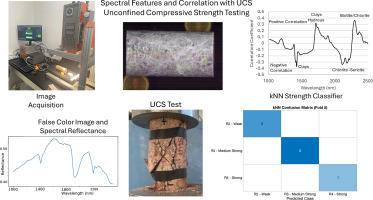从SWIR高光谱数据中分类单轴抗压强度(UCS)的概念
IF 8.4
1区 工程技术
Q1 ENGINEERING, GEOLOGICAL
引用次数: 0
摘要
随着低成本便携式光谱成像仪和光谱辐射计的发展,问题出现了:高光谱图像数据能否用于估计岩石的无侧限抗压强度(UCS) ?反射率、发射率、吸收率和透射率是岩石和矿物的基本性质。本研究的重点是将非破坏性高光谱图像与破坏性测试方法的数据进行关联。对32个蚀变花岗岩样品进行了短波红外(SWIR)高光谱成像。对岩心样品在1000 ~ 2500 nm范围内的反射率进行了分析。本研究的主要目的是确定与岩石强度相关的关键光谱特征,并将样品分为弱岩石、中等强度岩石和强岩石的ISRM强度类别。该方法包括数据预处理,基于平均光谱响应偏差的特征提取,以及识别显著光谱成分的统计分析。k-最近邻(kNN)分类器在中等强度和较强岩石类别中表现出可靠的性能,总体准确率达到90%。本文概述了实验过程、机器学习分析方法,并提出了进一步发展该技术的建议路径。最终目标是利用国际岩石力学学会(ISRM)的分类指南,开发更多的方法,从地表和钻芯数据的高光谱图像中量化UCS。本文章由计算机程序翻译,如有差异,请以英文原文为准。

A proposed concept for classifying uniaxial compressive strength (UCS) from SWIR hyperspectral data
With the development of lower-cost and portable spectral imagers and spectral radiometers, the question arises: Can hyperspectral image data be used to estimate the Unconfined Compressive Strength (UCS) of rock? Reflectance, emissivity, absorption, and transmission are fundamental properties of rock and minerals. This study focuses on correlating data from non-destructive hyperspectral images and destructive test methods.
Hyperspectral images of 32 altered granite samples were acquired in the Shortwave Infrared (SWIR). The reflectance from the 1000 to 2500 nm range of core samples was analyzed. The primary objective of this study is to identify key spectral features that correlate with rock strength and classify samples into ISRM strength categories for weak, moderately strong, and strong rock. The methodology encompasses data preprocessing, feature extraction based on deviations from the mean spectral response, and statistical analysis to identify significant spectral components. The k-Nearest Neighbor (kNN) classifier demonstrated reliable performance for moderately strong and strong rock categories, achieving an overall accuracy of 90 %. This paper outlines the experimental procedure, machine learning analysis methods, and a recommended path forward for further developing this technique. The ultimate goal is to develop additional methods for quantifying UCS from hyperspectral images of both surface and drill core data, utilizing International Society of Rock Mechanics (ISRM) classification guidelines.
求助全文
通过发布文献求助,成功后即可免费获取论文全文。
去求助
来源期刊

Engineering Geology
地学-地球科学综合
CiteScore
13.70
自引率
12.20%
发文量
327
审稿时长
5.6 months
期刊介绍:
Engineering Geology, an international interdisciplinary journal, serves as a bridge between earth sciences and engineering, focusing on geological and geotechnical engineering. It welcomes studies with relevance to engineering, environmental concerns, and safety, catering to engineering geologists with backgrounds in geology or civil/mining engineering. Topics include applied geomorphology, structural geology, geophysics, geochemistry, environmental geology, hydrogeology, land use planning, natural hazards, remote sensing, soil and rock mechanics, and applied geotechnical engineering. The journal provides a platform for research at the intersection of geology and engineering disciplines.
 求助内容:
求助内容: 应助结果提醒方式:
应助结果提醒方式:


